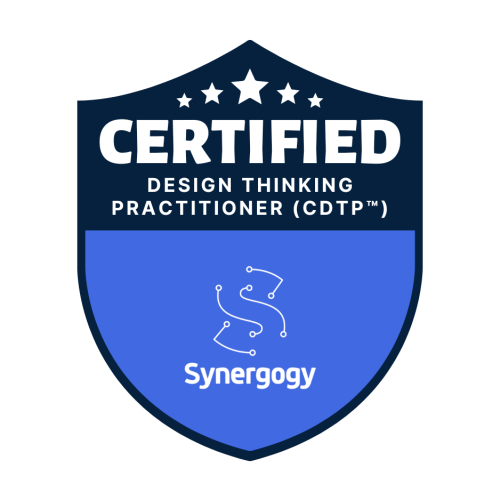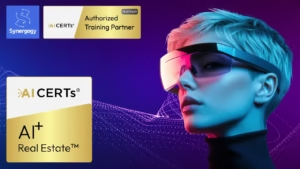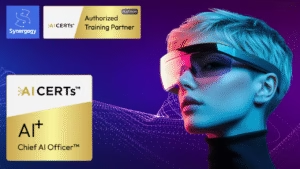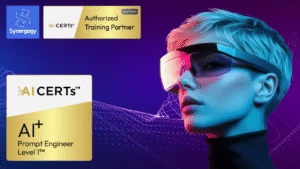- THE GOLD STANDARD IN DESIGN THINKING
Certified Design Thinking Practitioner (CDTP™)

Become a Design Thinking expert! The CDTP™ Design Thinking Certification course is endorsed by HRCI – Human Resource Certification Institute (HRCI) for 16 credits.
Constantly re-inventing your S-Curve is the key to innovation. Whether you are a start-up entrepreneur or a manager, whether you are an academician or in government – staying relevant is the key to survival. Design Thinking can help you create those ‘leapfrog’ ideas that change the game and get you the first movers advantage.
Whether you are designing a new product or service or simply a new go-to-market strategy, you need to challenge your thinking process.
Using design thinking principles, models and skills can help shift your mindset, lead teams toward constant innovation. Create products or services that deliver value for your organisation and its customers.
- Endorsed by HRCI
- Digital Badge
- Professional Certification
- Online or Face-to-face
Design Thinking - What's In It For You?
Breakthrough innovation happens at the intersection of user centricity, commercial viability, and technological feasibility. Design thinking integrates all three and delivers business value. Here are some important statistics that shed light on the criticality of Design Thinking for businesses today.
Greater Returns
design conscious companies have reported receiving greater returns than non-design led companies.
Work Culture
of organizations that practice design thinking report it has improved their working culture on a team level.
Digital Experience
of design-led companies say that their digital experiences outdo their competition's.
Customer Loyalty
of design-led companies report more loyal customers as a benefit to having advanced design practices.

Who should attend the Design Thinking Certification Course?
- CXOs
- Intact Business Units
- Cross Functional Project Team
- Start-up Professionals & Entrepreneurs
- Design Teams
- Product Teams
- Agile Teams
What is the course methodology?
True to our name, our approach is based on synergistic adult learning principles. Participants get plenty of hands on experiential learning opportunities through a variety of learning sources.
- Immersive Blended Learning
- Action Learning Exercises
- Case Studies
- Capstone Projects


What course materials are given to participants?
- Participant Workbook
- Design Thinking Templates
- Design Thinking Skills Cards
- Design Thinking Process Checklists
What are the benefits of getting certified by Synergogy?
- Professional Accreditation
- Digitally Authenticated Badge
- Lifetime License - No Renewals
- Action Learning

Choose from a Range of customizations
Choose from a range of solutions to suit your every need. Our Certified Design Thinking Practitioner CDTP™ course can be customised to your industry or business unit context. What’s more, we are happy to deliver this course face to face or in virtual, instructor-led formats.
Schedule a 30 minute call to discuss your Design Thinking needs.
Course Overview
Synergogy (si-ner-go-ji) has been at the forefront of Design Thinking for more than a decade. True to our name, our approach to learning is through synergistic andragogy. Our Design Thinking Certification course has been created with years of experience working in design labs along with clients from more than 20 industry sectors, globally.
This Design Thinking Certification course will help you learn how to leverage tried & tested design thinking models, principles and skills. The Certified Design Thinking Practitioner CDTP™ course helps you address business challenges and build products, services and strategies that deliver results.
This course provides you with all the necessary tools and skills to create a mindset change, adapt behaviors and learn new ways to tackle problems at work. With cohort based learning, plenty of practice and examples from various industries, this course will equip you to become an expert in Design Thinking. To build your Design Thinking muscle, you even get to work on a capstone project within your organisation.

Free download
Design Thinking
Ready Reckoner
- Design Thinking Process
- Design Thinking Skills & Behaviors
- Design Thinking Tools
New to Design Thinking? Download our one-pager that will get you kick-started on the basics.

Feel free to send us a message.
Design Thinking - FAQs
A comprehensive list of Design Thinking FAQs answered through our first hand experience in implementing Design Thinking over a decade.
Design thinking is a cyclical and non-linear process involving five phases—Empathize, Define, Ideate, Prototype and Test. It’s a human-centered approach that combines focus on people’s needs, technology and business viability – any one of the 3 missing and you don’t really see innovation.
Design thinking is “human-centered” – which means that it requires observation and recording of how people actually consume a product or experience a service and how to improve them in an iterative fashion. To be truly human-centered, designers watch how people use a product or service and continue to refine the product/service in an iterative and regular cycle.
Design thinking is a problem-solving approach that has its roots in the design community. It was first popularized as a term by David Kelley, the founder of IDEO, a design and innovation consultancy, in the late 1980s. However, the concept of design thinking has been around in some form or another for much longer.
Design thinking can be traced back to the Bauhaus School, a German art and design school that was established in 1919. The school brought together artists, architects, and engineers to work collaboratively on design projects, and this interdisciplinary approach became a model for design thinking.
Over the years, design thinking has evolved and been adopted by a variety of industries, including business, healthcare, and education. Today, design thinking is widely recognized as a powerful tool for innovation and has been embraced by organizations of all sizes, across a variety of industries and sectors.
In recent years, design thinking has been popularized by a number of influential thought leaders and has been the subject of numerous books, articles, and conferences. It has become an essential part of the innovation toolkit for organizations seeking to create new products, services, and experiences that are meaningful and impactful.
The Hasso Plattner Institute of Design at Stanford (aka the d.school) describes design thinking as a five-stage process. These stages are not always sequential, and teams often run them in parallel, out of order and repeat them in an iterative fashion.
Stage 1: Empathize—Research Your Users’ Needs
Empathy provides the critical starting point for Design Thinking. The first stage of the process is spent getting to know the user and understanding their wants, needs and objectives. This means observing and engaging with people in order to understand them on a psychological and emotional level. During this phase, the designer seeks to set aside their assumptions and gather real insights about the user.
Stage 2: Define—State Your Users’ Needs and Problems
The second stage in the Design Thinking process is dedicated to defining the problem. You’ll gather all your findings from the empathise phase and start to make sense of them while having a Systems Thinking approach: what difficulties and barriers are your users coming up against? What patterns do you observe? What is the big user problem that your team needs to solve? By the end of the define phase, you will have a clear problem statement. The key here is to frame the problem in a user-centered way.
Stage 3: Ideate—Challenge Assumptions and Create Ideas
With a solid understanding of your users and a clear problem statement in mind, it’s time to start working on potential solutions. The third phase in the Design Thinking process is where the creativity happens, and it’s crucial to point out that the ideation stage is a judgement-free zone! Designers will hold ideation sessions in order to come up with as many new angles and ideas as possible. Towards the end of the ideation phase, you’ll narrow it down to a few ideas with which to move forward.
Stage 4: Prototype—Start to Create Solutions
The fourth step in the Design Thinking process is all about experimentation and turning ideas into tangible products. A prototype is basically a scaled-down version of the product which incorporates the potential solutions identified in the previous stages. This step is key in putting each solution to the test and highlighting any constraints and flaws. Throughout the prototype stage, the proposed solutions may be accepted, improved, redesigned or rejected depending on how they fare.
Stage 5: Test—Try Your Solutions Out
After prototyping comes user testing, but it’s important to note that this is rarely the end of the Design Thinking process. In reality, the results of the testing phase will often lead you back to a previous step, providing the insights you need to redefine the original problem statement or to come up with new ideas you hadn’t thought of before.
Design thinking is a human-centered approach to problem solving that is characterized by certain principles and skills. The following are some of the key principles and skills that are typically associated with design thinking:
Empathy: Design thinking starts with a deep understanding of the people for whom you are designing, which requires empathy and a genuine desire to understand their needs and desires.
Define the problem: Design thinking requires that you start by clearly defining the problem that you are trying to solve. This requires a deep understanding of the context in which the problem exists and a clear definition of the problem space.
Ideation: Design thinking is characterized by a focus on generating as many ideas as possible, often through brainstorming and other ideation techniques.
Prototyping: Design thinking requires that you quickly turn your ideas into prototypes, which can be tested and refined. This allows you to iterate quickly and improve your designs based on feedback from users.
Testing: Design thinking requires that you test your prototypes with real users, in order to validate your assumptions and refine your designs.
Iteration: Design thinking is an iterative process, meaning that you will repeat the process of defining the problem, ideating, prototyping, and testing until you have arrived at a solution that meets the needs of your users.
Collaboration: Design thinking requires collaboration across teams and disciplines, including designers, engineers, business people, and users. This helps to ensure that the solution is grounded in a deep understanding of the problem and the needs of the users.
Experimentation: Design thinking encourages experimentation and taking calculated risks, in order to arrive at innovative solutions.
Optimism: Design thinking requires a sense of optimism and a belief that it is possible to find a solution to even the most difficult problems.
These principles and skills are interrelated and often overlap, and they are all important elements of the design thinking process. By adopting a design thinking approach, organizations can unlock their creativity and drive innovation, resulting in better products, services, and experiences for their users.
Design thinking has a number of benefits that make it an attractive approach for organizations and individuals who are seeking to solve complex problems and drive innovation. Some of the key benefits of using design thinking include:
Human-centered approach: Design thinking starts with a deep understanding of the people for whom you are designing, which helps to ensure that the solution is grounded in the needs and desires of the users.
Creativity and Innovation: Design thinking encourages the generation of a large number of ideas and the rapid prototyping and testing of those ideas, which can lead to more creative and innovative solutions.
Improved Problem Solving: Design thinking helps organizations to approach problems in a structured and systematic way, which leads to improved problem solving and decision making.
Collaboration: Design thinking requires collaboration across teams and disciplines, which can help to break down silos and improve communication and teamwork within organizations.
Customer Focus: Design thinking helps organizations to put the customer at the center of the design process, which leads to products, services, and experiences that are more meaningful and impactful.
Faster Time to Market: By using a rapid prototyping and testing approach, design thinking can help organizations to bring products, services, and experiences to market more quickly.
Increased User Satisfaction: By starting with a deep understanding of the users, design thinking helps organizations to create solutions that are more likely to meet the needs and desires of the users, leading to increased user satisfaction.
Increased Business Value: By driving innovation and creating more meaningful products, services, and experiences, design thinking can help organizations to increase their business value and achieve a competitive advantage.
These benefits make design thinking an attractive approach for organizations of all sizes and across a variety of industries, who are seeking to drive innovation and solve complex problems. By adopting a design thinking approach, organizations can create solutions that are more meaningful and impactful, and that are better suited to the needs of their users.
Design thinking can be applied to a wide range of problems and challenges, across a variety of industries and sectors. Some of the most common applications of design thinking include:
Product Design: Design thinking is often used to design consumer products, such as electronics, appliances, and toys.
Service Design: Design thinking can be used to design services, such as healthcare services, financial services, and customer service experiences.
Experience Design: Design thinking can be used to design experiences, such as museum exhibitions, theme park attractions, and live events.
Business Strategy: Design thinking can be used to develop new business strategies, such as developing new products and services, entering new markets, and improving operational efficiency.
Social Impact: Design thinking can be used to address social and environmental challenges, such as poverty, homelessness, and climate change.
Education: Design thinking can be used to design educational programs and curricula, as well as learning experiences for students.
Healthcare: Design thinking can be used to design healthcare solutions, such as new medical devices, patient experiences, and healthcare systems.
Public Policy: Design thinking can be used to address public policy challenges, such as transportation planning, urban development, and environmental protection.
These are just a few examples of the many applications of design thinking. The flexibility and adaptability of the design thinking approach make it well suited for solving a wide range of problems and challenges, across a variety of industries and sectors. By adopting a design thinking approach, organizations can drive innovation and create solutions that are more meaningful and impactful.
Here’s an example of how design thinking could be used to solve a problem:
Problem: A coffee shop wants to increase customer satisfaction and reduce customer wait times.
Empathize: The first step is to understand the customers and their needs. The coffee shop could conduct customer surveys, observe customers in the shop, and talk to customers to gain a deep understanding of their experiences and needs.
Define: Based on the insights gathered from the empathy phase, the coffee shop can define the problem more precisely. In this case, the problem might be defined as “Customers are frustrated with long wait times and a lack of seating.”
Ideate: In this step, the coffee shop can generate a large number of ideas to address the problem. For example, they might consider adding more seating, streamlining the ordering process, or offering mobile ordering.
Prototype: The coffee shop can then create prototypes of the most promising ideas. For example, they might create a mock-up of a redesigned ordering system, or build a prototype of a new seating arrangement.
Test: The coffee shop can then test the prototypes with customers to see which ideas work best. For example, they might ask customers to try out the new ordering system and provide feedback, or observe customers using the new seating arrangement.
Implement: Based on the results of the testing phase, the coffee shop can implement the best solution. For example, they might implement the new ordering system, or rearrange the seating to reduce wait times and improve customer satisfaction.
This example illustrates how design thinking can be used to solve a problem in a structured and systematic way. By using design thinking, the coffee shop was able to gain a deeper understanding of its customers and develop a solution that addresses their needs and improves customer satisfaction.
Design thinking and agile are both approaches to problem-solving, but they have some key differences.
Design thinking is a human-centered approach to problem-solving that focuses on understanding the needs and perspectives of users. The design thinking process typically involves empathizing with users, defining the problem, ideating potential solutions, prototyping and testing, and refining the solution.
Agile, on the other hand, is a project management methodology that emphasizes flexibility and collaboration. Agile is commonly used in software development, but it can be applied to any project that requires rapid iteration and adaptation to changing requirements. The agile process involves breaking a project into smaller, manageable chunks called “sprints,” and regularly reassessing and adjusting the project plan based on feedback and results.
While design thinking and agile share some similarities, such as a focus on collaboration and iteration, they are used for different purposes and at different stages of the problem-solving process. Design thinking is often used at the beginning of a project to identify and understand user needs, while agile is used during the implementation phase to manage the project and ensure that it is on track. In some cases, both design thinking and agile may be used in combination to address a problem, with design thinking informing the initial problem definition and agile being used to manage the project and ensure a successful outcome.
Design thinking and the waterfall process are two different approaches to project management.
Design thinking is a human-centered, iterative approach to problem-solving that involves empathizing with users, defining the problem, ideating potential solutions, prototyping and testing, and refining the solution. Design thinking emphasizes collaboration, flexibility, and experimentation, and is often used for complex problems where a clear solution is not immediately apparent.
The waterfall process, on the other hand, is a sequential, linear approach to project management that is characterized by distinct phases that must be completed before moving on to the next phase. The waterfall process typically involves requirements gathering, design, implementation, testing, and deployment. The process is characterized by a clear separation between each phase, and changes to the project plan are difficult to make once a phase has been completed.
The main difference between design thinking and the waterfall process is that design thinking is flexible and iterative, while the waterfall process is more rigid and sequential. Design thinking allows for more experimentation and adaptation, while the waterfall process is better suited for projects where the requirements and solution are well understood. In general, design thinking is a more flexible approach that is better suited for complex, uncertain problems, while the waterfall process is more structured and suited for well-defined problems with clear solutions.
Design thinking and user experience (UX) design are related but distinct approaches to problem-solving.
Design thinking is a human-centered approach to problem-solving that emphasizes empathy, experimentation, and iteration. The goal of design thinking is to understand the needs and perspectives of users, and to use that understanding to develop solutions that meet their needs. Design thinking is often used at the beginning of a project to inform the problem definition and ideation phase.
UX design, on the other hand, is the process of designing products or services that are usable, accessible, and desirable for the people who use them. UX design takes into account the various stages of the user’s interaction with a product or service, including their goals, the tasks they need to complete, and the emotions they experience. UX designers use a variety of tools and techniques, such as user research, prototyping, and usability testing, to create products and services that provide a positive and seamless experience for the user.
While design thinking and UX design share some common goals and techniques, the main difference between the two is their focus. Design thinking is a more general approach to problem-solving that is used across a wide range of industries and disciplines, while UX design is a specific discipline focused on creating great user experiences. In many cases, design thinking informs the initial stages of a UX design project, while UX design focuses on the implementation and testing of the solution.
Design thinking can be a valuable tool for product development because it is a user-centered and iterative approach that helps ensure that the final product meets the needs of the people who will be using it.
The design thinking process typically involves the following steps:
Empathize: Gaining a deep understanding of the users, their needs, and the problems they are trying to solve.
Define: Clearly defining the problem that the product is trying to solve, taking into account the user’s perspective and needs.
Ideate: Generating a wide range of potential solutions to the problem, without worrying about feasibility or practicality at this stage.
Prototype: Creating physical or digital prototypes of potential solutions, which can be tested and refined.
Test: Testing the prototypes with users to gather feedback and iteratively refine the solution.
By using design thinking, product development teams can ensure that they are developing a solution that is based on a deep understanding of the users and their needs, rather than just on their own assumptions or preconceptions. This leads to a better end product that is more likely to be adopted and successful in the marketplace.
In addition, the iterative and flexible nature of design thinking helps product development teams to quickly identify and correct problems with the product, and to make changes as needed in response to feedback from users. This helps to minimize the risk of developing a product that doesn’t meet the needs of the market, and can result in a faster time to market.
Design thinking, lean, and agile are all methodologies that can be used to improve the efficiency and effectiveness of product development. While each methodology has its own unique focus and approach, they can complement and reinforce each other when used together.
Design thinking provides a user-centered approach to problem-solving, helping teams to understand the needs and perspectives of users and to develop solutions that meet their needs.
Lean is a methodology that emphasizes the continuous improvement of processes and the elimination of waste. It helps teams to identify and eliminate unnecessary steps in the product development process, streamlining the process and reducing time to market.
Agile is a flexible and iterative approach to project management that emphasizes collaboration, transparency, and constant adaptation to change. Agile helps teams to work together more effectively, respond quickly to changes in the market or in customer needs, and deliver high-quality products.
When used together, design thinking, lean, and agile can provide a powerful framework for product development that combines a deep understanding of user needs, a focus on continuous improvement and efficiency, and the flexibility to respond to change. By working together, these methodologies can help teams to develop better products, faster, and with less risk.
Design thinking and OKRs (Objectives and Key Results) can be complementary approaches to product development and management. Design thinking provides a user-centered and iterative approach to problem-solving, while OKRs provide a structured framework for setting and tracking progress towards specific, measurable goals.
In the context of product development, design thinking can inform the early stages of the OKR process, helping teams to understand the needs and perspectives of users and to define meaningful and achievable goals for the product. The outputs of the design thinking process, such as user personas, problem statements, and potential solutions, can be used to inform the objectives and key results of the OKRs.
Once the OKRs have been established, the design thinking process can continue to inform the development and testing of the product. The iterative and flexible nature of design thinking can help teams to adapt to changes in the market or in customer needs, and to make necessary modifications to the product to ensure that it meets the objectives and key results of the OKRs.
By using design thinking in combination with OKRs, teams can ensure that they are developing a product that is not only aligned with specific goals and objectives, but also based on a deep understanding of the needs and perspectives of users. This can result in a better end product that is more likely to be successful in the marketplace.
Our Blog

AI Certification for Real Estate Professionals in UAE
AI Certification for Real Estate Professionals in UAE. Future Proof Your Property Career with AI Plus Real Estate Certification How AI Is

Chief AI Officer (CAIO) Certification in the UAE
Become a certified Chief AI Officer in the UAE with Synergogy’s globally recognized AI leadership

Prompt Engineering Level 1 Certification in the UAE
Master prompt engineering with the UAE leading accredited certification designed for AI driven professional growth.

DISC Certification: 6 & 7 Feb. 2026
Join the Online DISC Certification on 6 & 7 Feb. 2026 to master human behavior